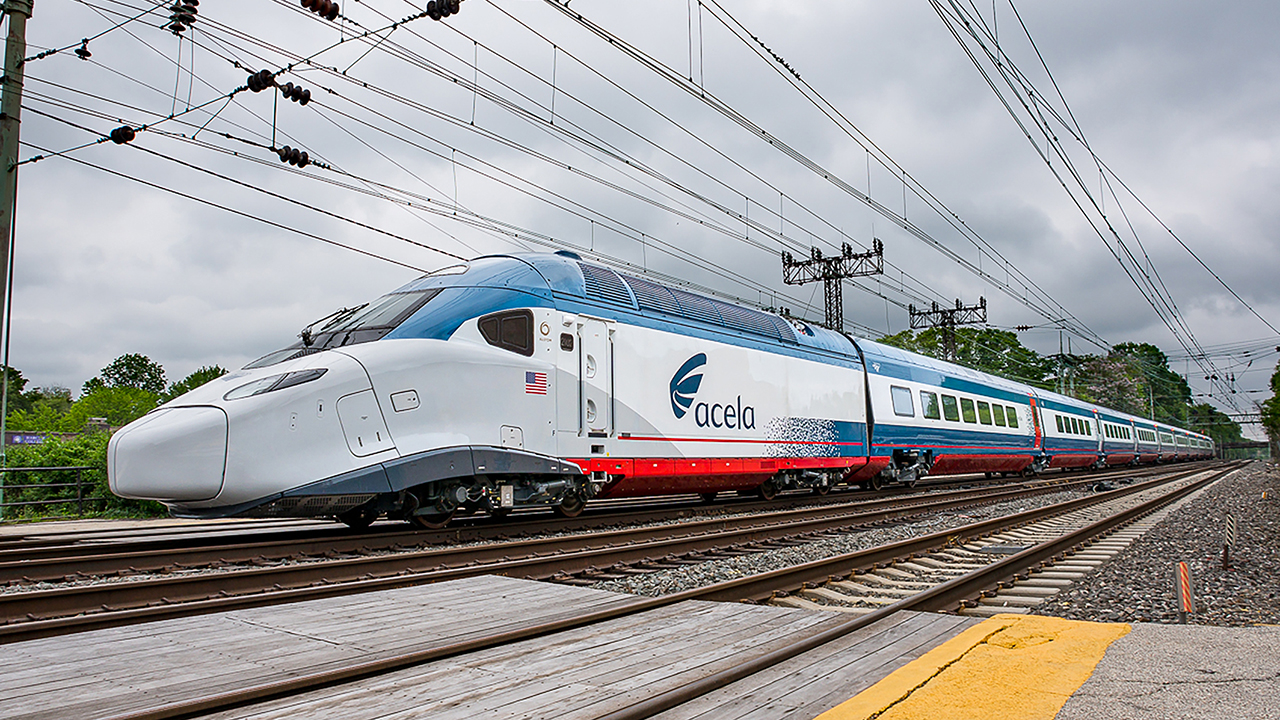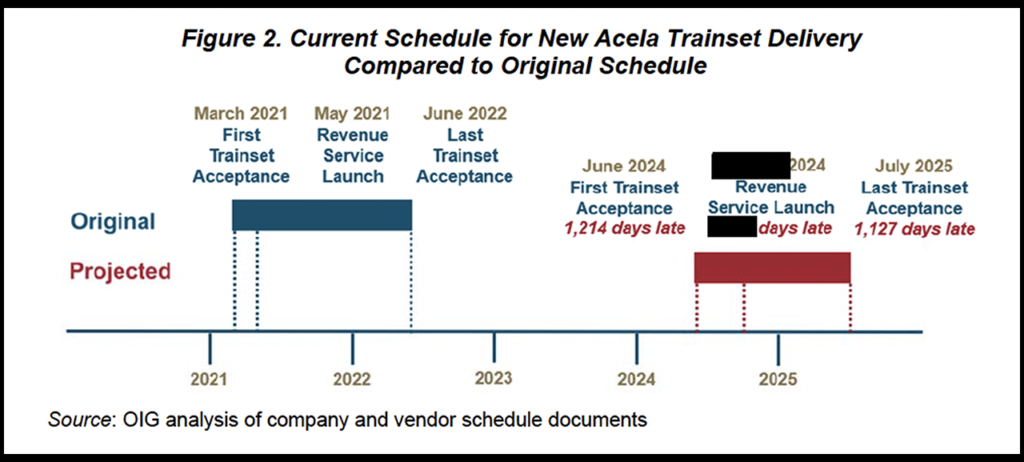
Amtrak OIG: New Acela Program Facing Additional Delays, Increased Costs (Updated with Alstom and OIG Responses)
Written by Marybeth Luczak, Executive Editor
2nd test run of Pre-production Acela II on the PH Line. Amtrak has full rights to this image. New Acela 21 in Testing
More delays are anticipated for Amtrak’s new Acela trainsets, already three years behind schedule, due in part to defects and designs not yet meeting Federal Railroad Administration (FRA) requirements, the latest Amtrak Office of Inspector General (OIG) report has found. Alstom has taken exception to certain elements of the report. OIG stands by it.
Current delays “have already resulted in significant cost increases, operational impacts and delayed revenue,” OIG said.

Amtrak in 2014 initiated the $2.3 billion New Acela Program to replace its aging fleet of high‐speed trainsets on the Northeast Corridor (NEC). “America’s Railroad” in August 2016 contracted Alstom to develop and manufacture 28 new trainsets, which were initially scheduled to begin revenue service in May 2021 (see chart above). As of July 2023, OIG said, 12 of the 28 serial trainsets and 22 of the 28 café cars had been produced, but Amtrak had not accepted any trainsets as of August 2023. Also as of July 2023, OIG reported that Amtrak has spent approximately $1.6 billion on the entire program; the figure covering the trainset acquisition alone was redacted in the report (scroll down to download). OIG noted that Amtrak plans to launch revenue service with the first six functional trainsets that are delivered. The railroad’s most recent goal for a revenue service launch is 2024.
OIG said it has identified two reasons for the current—and “likely future”—delays:
- Trainset designs have not yet met FRA requirements. Federal regulations require Amtrak “to submit to FRA trainset performance predictions from a computer model showing that the model is valid and the trainsets are safe to proceed with required testing,” according to OIG. “Although the company must submit these predictions to FRA for approval, the vendor is responsible for developing and validating the model. Contrary to leading practices, however, the vendor started producing serial trainsets before it validated the model. [OIG noted in the report that Alstom has produced 14 full trainsets: 12 serial trainsets and two prototypes that are not considered serial trainsets.] Now, three years after starting serial production, the vendor has built more than half of all units, but has not yet validated the model, which is the first step in a multi-step regulatory testing process.” OIG reported that Amtrak officials “told us they did not object to the vendor proceeding into production because, among other things, they were overly optimistic about the vendor’s progress and believed the vendor’s assurances that validation was close. Without a validated model, FRA will not let the company move forward with the rest of its required testing. Until the company completes testing, the trainsets cannot operate in revenue service let alone at the advertised speed of 160 miles per hour.”
- Trainsets have defects, and the schedule for addressing them is “incomplete.” According to OIG, all 12 serial trainsets and 22 café cars produced have defects—“some that require structural and design modifications and others that require sealant, drainage, or corrosion corrections.” Although some defects are expected when producing a new trainset, OIG said, Alstom’s schedule for addressing them is incomplete and Amtrak “has not been successful in obtaining more complete scheduling data … Without more complete information, the company cannot verify whether remediating the defects will impact the overall program schedule and the revenue service launch.”
The issues the OIG identified are similar to those that have occurred during other Amtrak rolling stock acquisitions, according to the report. With Amtrak planning a multi-billion dollar program to replace its fleet of long-distance trains while it is also engaged in the ongoing process of replacing its intercity trains, the OIG recommended the following three actions to Amtrak:
- “Enhance the company’s formal processes, tools, and techniques to ensure that it regularly captures lessons learned from this and other rolling stock acquisitions and incorporates them into ongoing and future rolling stock procurements.”
- “Direct the vendor to provide complete schedules to address field modification instructions. At a minimum, this would include the location of work, viable engineering solutions, and the availability of materials and personnel.”
- “Work collaboratively with the vendor to identify the risk of future field modification instructions, as well as any modifications needed as a result of the model validation efforts, and develop plans to mitigate their schedule impact.”
In commenting on a draft of OIG’s report, Amtrak Executive Vice President, Capital Delivery Laura Mason “agreed with our recommendations and described the company’s plans to address them,” according to OIG. Following are the OIG-summarized responses from Amtrak:
- “Recommendation 1: Management agreed with our recommendation to enhance its formal processes, tools, and techniques to ensure that it regularly captures lessons learned from this and other rolling stock acquisitions. Management outlined its ongoing and planned enhancements to its Enterprise Project and Portfolio Management system—the company‐wide unified project management system that includes a lessons learned module. The target completion date is February 29, 2024.”
- “Recommendation 2: Management agreed with our recommendation to direct the vendor to provide more complete schedule information to address field modification instructions. Management stated that it will request the vendor to expand the current spreadsheet and include information on the location of planned work and the availability of material and personnel. The target completion date is November 30, 2023.”
- “Recommendation 3: Management agreed with our recommendation to work collaboratively with the vendor to identify the risk of future field modification instructions to mitigate the schedule impact. Management stated it will build on its ongoing efforts with the vendor in modeling, testing, and quality. It also stated it plans to expand these efforts to include increased joint working sessions and weekly touch-point meetings, a monthly review of risk areas, and the development of risk mitigations steps to try and reduce the impact to the overall schedule. The target completion date is May 31, 2024.”
ALSTOM RESPONSE
“Alstom is the world leader in high-speed trains, with more than 40 years of experience designing and manufacturing this technology and nearly 2,300 high-speed trains in service built by Alstom, or built with Alstom parts and technology,” the company said in a statement to International Railway Journal Editor-in-Chief Kevin Smith. “We share Amtrak’s excitement in bringing this technology to America.”
“Alstom is working closely with the Federal Railroad Administration and Amtrak as we work through their first-ever safety certification for high-speed trains to ensure that these new trains meet all FRA requirements for entry into service. As part of the validation, in addition to ongoing modeling activities, we have already successfully run these trains on the FRA’s Pueblo, Colo. test track at high speed and on the Northeast Corridor for a total of nearly 70,000 miles.
“Alstom continues to produce these, the first American, union-made, high-speed Avelia Liberty trains in Hornell, N.Y. It is industry standard to begin production simultaneously with validation. As we proceed through the process to have these trains validated by the FRA, Alstom has shipped 9 out of 28 trains and are storing a number of them offsite to ensure a continuity of production.
“We are surprised with so-called ‘defects’ that the OIG report identifies. Every train that has been released from the manufacturing site were authorized for shipping by Amtrak after thorough inspections, with identified modifications to be completed prior to acceptance. These modifications will be completed before final acceptance of the trainsets, as it is foreseen in the contract and customary in our industry. These modifications, along with additional changes that has Amtrak requested are in no way in the critical path of completion of this project.”
Said one industry observer, “The word ‘defect’ is not accurate, as there are issues on both sides. The OIG report is politically driven. It’s easier to kick the supplier rather than properly take responsibility.”
OIG RESPONSE
Amtrak OIG Congressional & Public Affairs officer Clark Carpenter responded to Railway Age: “Amtrak OIG, both by federal law, and through policy and agreements with Amtrak, operates independently of the company to provide oversight on Amtrak’s programs and operations. Amtrak OIG conducts audits and investigations and issues reports relating to Amtrak programs, personnel, and operations that, in the Inspector General’s judgment, are necessary or desirable, and Amtrak cannot prevent or prohibit the Inspector General from initiating, carrying out, or completing any audit or investigation, or from issuing any subpoena during an audit or investigation. We are funded annually by a federal appropriation that is separate from the funding Amtrak receives via the Federal Railroad Administration. In addition, Amtrak management cannot interfere with our operations, and, conversely, members of our staff do not engage in any programmatic functions that support Amtrak’s management or operations. We stand by the observations we have made in this report.”
WASHINGTON POST REPORT
In May, The Washington Post reported that the “Avelia Liberty” trainsets were experiencing “complications in completing testing … along the [NEC’s] decrepit infrastructure.” They “need more analysis to ensure they can safely operate on the curvy and aging tracks between Washington and Boston.” Numerous delays have been attributable to “unforeseen complexities in testing and computer simulation processes required by the FRA. Amtrak and … Alstom have cited some compatibility hiccups between the high-tech train, modeled after those in operation across Europe, and infrastructure that dates back 190 years in some areas. The latest hurdle, officials said, involves testing the train’s wheels, particularly at higher speeds.”
“Modeling of the wheel-to-track interface is particularly complex due to age, condition, and specific characteristics of Amtrak infrastructure on the Northeast Corridor, and especially the existing tracks,” Alstom told the Post, adding that it has been “conducting extensive investigations” to ensure safe operation and is “confident that this extensive process will demonstrate compatibility of the latest generation of high-speed technology with existing infrastructure.” At the time the Post published its report, six trainsets had been delivered; a seventh was nearing completion.
“Further refinement of analysis, simulations and testing” are required, Amtrak told the Post. “We want our customers to experience these new trains as soon as possible, but Amtrak cannot operate them for passenger service until Alstom has completed testing and meets all safety requirements.”



